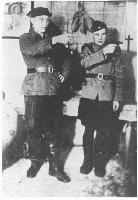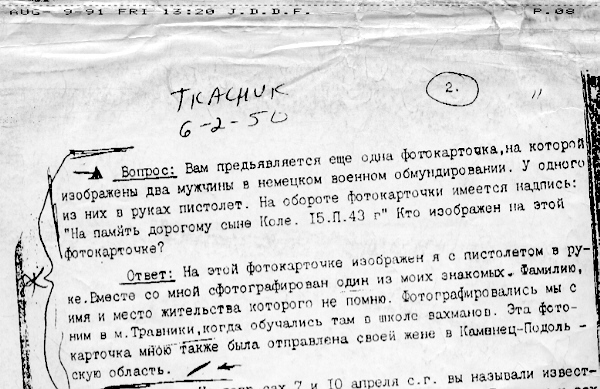
Marchenko Pointing Photo
|
11 March 2001 |
 Marchenko Pointing Photo |
|
VASILENKO, SERGEY STAPANOVYCH 6 March 1961 p 5: QUESTION: Who is photographed in photograph, where a man is standing with a pistol, and the other one is showing him something? ANSWER: On the photograph is depicted the wachman of the "SS" forces of the Treblinka death camp, Tkachuk — I do not recall his first name or patronymic; Tkachuk is photographed with a pistol in the right hand together with him is standing the motorist of the gas chamber ('Dushehubka') of the Treblinka camp, Marchenko Ivan. Both of them are photographed in the uniform of wachmen of the "SS" forces (vakhmanov voysk "SS" — transl.). NO 85-3435, In the United States Court of Appeals for the Sixth Circuit, John Demjanjuk v. Joseph Petrovsky, et al., Petitioner's Appendix Volume One, p. 00058. Errors and irregularities were in the original, as was parenthesized material. Red emphasis added. |
|
VASILENKO 6 March 1961 p 26: the present photograph was shown on 6 March 1961 to the witness Vasylyenko, Sergey Stepanovych, who stated that in the picture are photographed wachmen of the 'ss' forces serving in the Treblinka death camp, Tkachuk and Marchenko Ivan. With pistol in his right hand is the wachman — Tkachuk, standing alongside him is the motorist of the dushehubka Marchenko Ivan. Signature of Witness: 'Vasilyenko' NO 85-3435, In the United States Court of Appeals for the Sixth Circuit, John Demjanjuk v. Joseph Petrovsky, et al., Petitioner's Appendix Volume One, p. 00058. Errors and irregularities were in the original, as was parenthesized material. Red emphasis added. |
|
INTERROGATION REPORT 9 March 1961, City of Vinnitsa TKACHUK Ivan Kondratyevich .... In photograph no 3 I am depicted with the machinist of the gas chambers ('dushehubka') of the Treblinka death camp, Ivan Marchenko... NO 85-3435, In the United States Court of Appeals for the Sixth Circuit, John Demjanjuk v. Joseph Petrovsky, et al., Petitioner's Appendix Volume One, p. 00084. Errors and irregularities were in the original, as was parenthesized material, as were ellipses. Red emphasis added. |
 02-Jun-1950 Question: You are presented with one more photograph showing two men in German military uniforms. One of them is holding a pistol in his hand. On the back of the photograph is the inscription: "Memento for my dear son, Kolya. I5.II.43" Who are the people appearing in this photograph? Answer: I am shown in this photograph holding the pistol in my hand. Together with me is photographed one of my acquaintances. I do not remember his surname or first name, or place of residence. We were photographed together in the Trawniki camp, when we were studying in the sentry school. I sent this photograph also to my wife in Kamianets-Podilsky oblast. I5.II.43 could mean 15.11.43, which would be 15-Nov-1943; or it could mean 15.II.43, which would be 15-Feb-1943. As the correspondence is between Americans, 6-2-50 likely refers to 02-Jun-1950. For "sentry," Tkachuk uses a Russian derivative of the German "Wachmann." Red emphasis added. |
|
INTERROGATION REPORT 25 March 1965 City of Krasnodar TKACHUK Ivan Kondratyevich ... Question: Whom do you remember from among the traitors to the Motherland serving with you in the Treblinka death camp? Answer: Besides those I have already named from the Treblinka death camp I remember well the zugwachmen Pilman and Trebel or Schtrebel, the oberwachman Levchishin, the motorists of the 'dushehubka' Marchenko and Shalayev, the wachmen Sklyyudov, Vedernikov, Shilov, Kulak, Lyachenko and Ryabtsev. . . . NO 85-3435, In the United States Court of Appeals for the Sixth Circuit, John Demjanjuk v. Joseph Petrovsky, et al., Petitioner's Appendix Volume Three, p. 00834. Ellipses were in the original. "Dushehubka" refers to a gas chamber, or to a building housing more than one gas chamber; though sometimes it can refer to a "gas van." Red emphasis added. |
|
She was also able to relate that when she was still a girl, in the late '40s and early '50s, KGB men had often come to their home, confiscating all photographs of her father except for the wedding picture she had shown to Nishnic. The KGB had never explained why they took her father's photographs, or what he was suspected of.
Yoram Sheftel, The Demjanjuk affair: The rise and fall of a show-trial, Victor Gollancz, London, 1994, p. 319. |
|
CLEVELAND (AP) — A relative of convicted Nazi war criminal John Demjanjuk said Tuesday a copy of a photograph showing two Treblinka death camp guards proves Demjanjuk's allegation of mistaken identity. [...] Nishnic said the Israeli prosecutor in the case, Michael Shaked, obtained a copy of the photograph in May from the Soviet Union and supplied it to Demjanjuk's lawyer, Yoram Sheftel, during this past weekend. Nishnic said the defense lawyer was told the photo, along with other documents, would be placed in the Israeli Supreme Court's case file Tuesday. The photograph, according to Nishnic, shows two death camp guards in uniforms the Nazi SS supplied guards at Treblinka. Nishnic said documentation supplied Israel's high court includes testimony from a man who identified himself as one of the guards in the picture and the other was the notorious, so-called "Ivan the Terrible." M. R. Kropko, Associated Press writer, Photo Allegedly Shows Other As Ivan At Treblinka, 30-Jul-1991. |